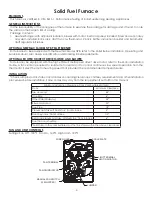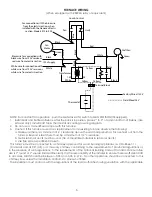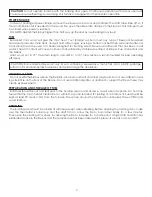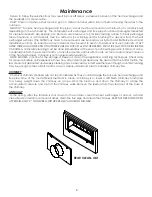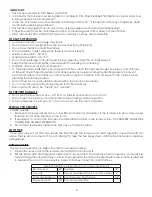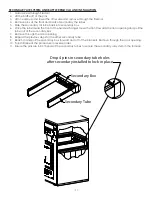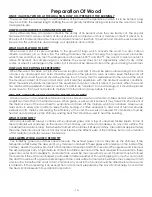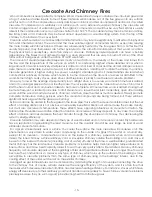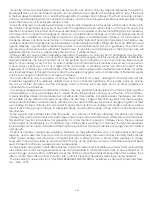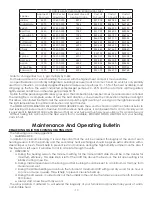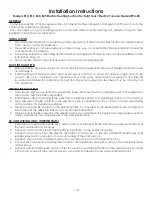
-14-
ONCE I HAVE MY WOOD AT THE LOCATION, HOW DO I PREPARE IT FOR BURNING?
The wood must be cut to length to suit the firebox of the stove of the appliance in which it is to be burned. A log
may be cut into the desired length. Splitting the wood greatly facilitates drying and reduces the wood to a more
manageable size.
HOW MUCH MOISTURE IS CONTAINED IN WOOD?
Many softwoods have a moisture content in the vicinity of 55 percent when they are freshly cut. The popular
hardwoods have moisture contents of about 45 percent. Air dried wood has a moisture content of about 16 to
22 percent. Kiln dried lumber may have a moisture content of less than 10 percent and should never be used as
firewood as this will over fire and damage your appliance and controls.
WHAT CAUSES WOOD TO ROT?
When wood is cut, it is very susceptible to the growth of fungi, which converts the wood to water, carbon
dioxide, and heat, just as does a fire. This rotting decreases the wood’s energy. The fungi are most productive
when three conditions are met: the temperature is between 600 °F and 900 °F, the wood’s moisture content is
above 30 percent, and ample oxygen is available. Thus, wood does not rot appreciably when it is dry, in the
winter, or when it is submerged in the water, but it should not be allowed to lie on the ground during the summer.
HOW CAN THIS ROTTING BE PREVENTED?
When the wood has been cut into stove wood lengths, and split, it should be piled outside during the months
of June, July, and August. Two poles should be placed on the ground to serve as rails to keep the firewood off
the moist ground and the wood should be piled up in such a way that it is well exposed to the sun and the wind.
The moisture content of the wood will drop until it reaches equilibrium with the ambient weather conditions.
When the relative humidity is 60 percent, the equilibrium moisture content is about 11 percent. When the wood
has reached this equilibrium moisture content, it is said to be “air dried.” Around mid August, it should be placed
under cover so that it will not reabsorb moisture from the rain and snow before it is used.
WHY THIS CONCERN ABOUT ALLOWING THE WOOD TO DRY?
Green or wet wood is undesirable for several reasons. Green or wet wood tends to mildew and rot which causes
a significant reduction in the thermal value. When green or wet wood is burned, it may take 20 to 25 percent of
the thermal value of the wood heat to evaporate and drive off the moisture, which is contained. Green wood
does not burn easily and, in order to keep the fire burning, it is often necessary to add a lot of fuel and provide
excessive draft, thereby decreasing the efficiency of the unit. The excess air needed for combustion must be
heated and it escapes up the chimney wasting heat that should be used to heat the building.
WHAT IS CREOSOTE?
Wood smoke almost always contains some unburned gases and a fog of unburned tar-like liquids. Some of
these materials will condense on the inside of the chimney, just as steam condenses on any cold surface. This
condensation is a black, tacky, fluid when first formed. When it dries, it is flaky and shiny. Creosote has approximately
the same thermal value as fuel oil. Not only does it reduce the effective size of the chimney, but an accumulation
of this material constitutes a serious fire hazard.
DOES GREEN WOOD CAUSE CREOSOTE?
Yes. Indirectly, green wood does cause creosote. The exhaust gases cool as they rise up the chimney. If the
temperature falls below the dew point, any moisture contained in these gases will condense on the inside of the
chimney, absorb the various products of incomplete combustion and form creosote. When green wood is burned,
the exhaust gases carry a high moisture content in addition, because of the heat required for evaporation, these
gases are cooler and more likely to condense than would be the case with dry wood. Charcoal may be formed
more readily if the unit is overcharged, particularly in milder weather. With overcharging (too much wood in unit)
the draft fan will be off a greater percentage of time, coals will be formed which will become covered with ash
and in turn will smother the coals to form charcoal. Any coals in the furnace should be stirred before more wood
is added to it. The preceding is an excerpt from a document prepared by the Nova Scotia Energy Council and
the Nova Scotia Research Foundation Corporation.
Preparation Of Wood
Summary of Contents for WFA-85
Page 21: ...21 Notes...


